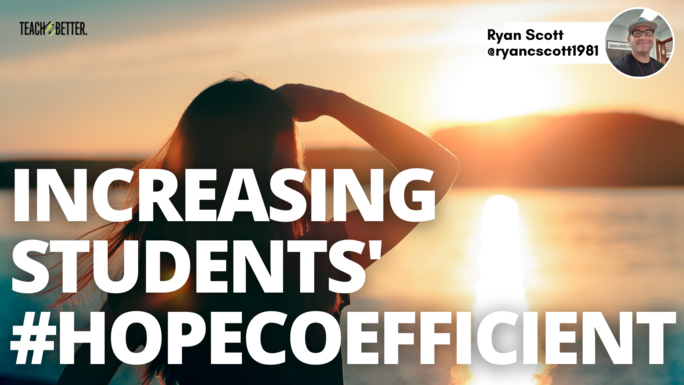TL;DR:
- We must consider the benefits of increasing students’ #hopecoefficient.
- We should seek to develop hope among students to counteract this epidemic.
- This post shares 13 tips to help students find their direction and purpose.
Let’s revisit
If you weren’t able to catch my last piece concerning the #hopecoefficient, you can check it out here. In a nutshell, I discussed poverty and learned helplessness as a side-effect. I introduced the idea that the world of education could and should seek to develop hope among its students to counteract this epidemic.
In this blog, I wanted to lay out the 4 Seeds of Hope, as Dr. Robert D. Barr calls them, and give some of the “why” behind each one.
Yes, the school should work to build a student’s pride in his/her family, culture, community, or school. However, the primary goal needs to be the development of that child’s sense of personal pride and self-esteem! Click To TweetOptimism
When I was a teen, optimism was NOT something that came naturally to me. In fact, my therapist at the time gave me a copy of the book Learned Optimism. Sadly, I didn’t think it’d work so I never even opened the first page! Hindsight is soooo 20/20…
Eric Jensen, who is a rockstar in the world of educating students from poverty, says that it is CRUCIAL to develop learned optimism and hope to turn students with a lower socioeconomic status into high achievers. As I’ve long suspected, psychology must come before pedagogy!
“School” may be the most important factor in not just instilling basic human hope and optimism, but in overcoming negative influences of, sadly, many poverty-level homes and communities. When schools with a strong atmosphere of optimism and classrooms with high expectations and positive reinforcement are the norm, educators can teach students more effectively and transform their brains, IQs, and lives!
A sense of optimism can be created through a welcoming environment, an atmosphere of respect and safety, an emphasis on success, community-wide celebrations, an emphasis on the positive, high expectations, and coordination of community services.
Let’s help our kids to feed the positive dog daily!
Sense of Belonging
How many of us have those kids in our building that just do not seem to fit into any social group? Many of us see kids that sit by themselves at lunch, play by themselves at recess, or tend to stay to themselves. Now I’m not saying this is inherently bad, but I tend to worry about these kids.
There is a TON of research from the fields of sociology, psychology, and education that has documented the positive outcomes associated with strong social connections and being part of a group: better grades, better attendance, less bullying and violence, and a decrease in risky behavior.
Maslow places finding a place of acceptance and belonging just above safety on his hierarchy of needs. Sadly, these students, without a sense of belonging, tend to experience more anxiety, eating disorders, depression, and low achievement. For our poverty-level students, finding that place of acceptance and belonging is VITAL to effective learning!
To create a sense of belonging at school, try to build relationships, create a surrogate family at school, develop students’ interests and talents, explore careers, and use social networking to enhance belonging. What ideas come to mind as you read these suggestions?
Self-Love
My good friend, Laura Rizo (@lauramrizo14), preaches the gospel of self-love EVERYWHERE she goes. If you haven’t followed her on Twitter, do it NOW! She’s well-versed in the benefits of why pride, self-esteem, and self-confidence are ESSENTIAL components of a fruitful life.
Based on what we know about poverty and its impact on children, the explicit and systematic development of these “self-love” concepts is essential for educating students from low-income families. When the human needs of children and youth are pinpointed, student attitudes and achievement improve. Who doesn’t do better when they feel better?!
Yes, the school should work to build a student’s pride in his/her family, culture, community, or school. However, the primary goal needs to be the development of that child’s sense of personal pride and self-esteem!
Again, my friend Bob Barr suggests that creating a culture of self-love within your school takes high expectations and positive reinforcement, positive personal connection with an adult, assumption of responsibility, service learning, self-monitoring of learning, academic success, and student-directed conferences. Easy? NO. Worth it? YES!
Purpose
Having worked for 14 years, in multiple districts, seeing generational poverty running rampant, I saw many students that lack a sense of purpose and receive little guidance and direction regarding how to transition from the dependency of youth to independent adulthood. When kids aren’t getting what they need at home, that’s where WE step in. In loco parentis, right?
One of my #bigEDideas is to create a purpose-driven school where everyone in the building—both adults and students—believes in themselves and their future. Schools should help students believe that they can achieve their purpose and should help them develop effective strategies toward that end. For our most vulnerable students, those from generational poverty, the development of a sense of purpose may be keenly important for addressing the issues of external locus of control and internalized learned helplessness!
In Maslow’s hierarchy of needs, self-actualization was at the top of the pyramid. But to reach that apex, one must have found his/her purpose in life. He said, “a musician must make music, an artist must paint, a poet must write if he is to be ultimately happy.” Shouldn’t we strive to help our students find what excites their souls prior to them leaving us?
[scroll down to keep reading]The following strategies for helping kids find their direction and purpose are based on the work of Damon, Pink, and Jensen.
These include:
- Helping students see more relevance in their studies.
- Focusing on intrinsic rather than extrinsic motivation.
- Developing community assets that support the healthy psychological growth of youth.
- Expanding students’ horizons.
- Developing their interests and talents through participation in school clubs and activities.
- Fostering autonomy.
- Engaging students in reflective inquiry.
- Providing learning options.
- Reducing the emphasis on standardized tests.
- Continually reminding students that they CAN succeed.
- Helping students set goals and master the strategies to achieve them.
- Encouraging students to dream and dream realistically.
- Encouraging hard work and persistence.
If this is a pipedream, call me the plumber!
Some would, and have, said that school is meant to be a place of academic pursuits. They’ve said that the idea that schools as a place where the world is changed is nothing more than a pipedream, dreamt by EDhippies that grew up on a steady diet of Dave Matthews and The Grateful Dead.
Well, if that’s the case, then sign me up to be the plumber that fixes this system! We live in a world that sometimes seems utterly devoid of hope. At a time when the world at times seems hopeless, shouldn’t our schools be refuges of HOPE?!
About Ryan Scott
Ryan is currently a high school AP in lovely Webster County, Kentucky. Prior to his current role he served as an elementary principal and classroom teacher. Throughout his 14 years in ED, he has been adamant about doing WHATEVER it takes to get students to the next level of life, WHATEVER that may look like. As an ED disruptor, he feels very strongly that SKILLS and not simply standards are what is needed for the jobs of the future!




